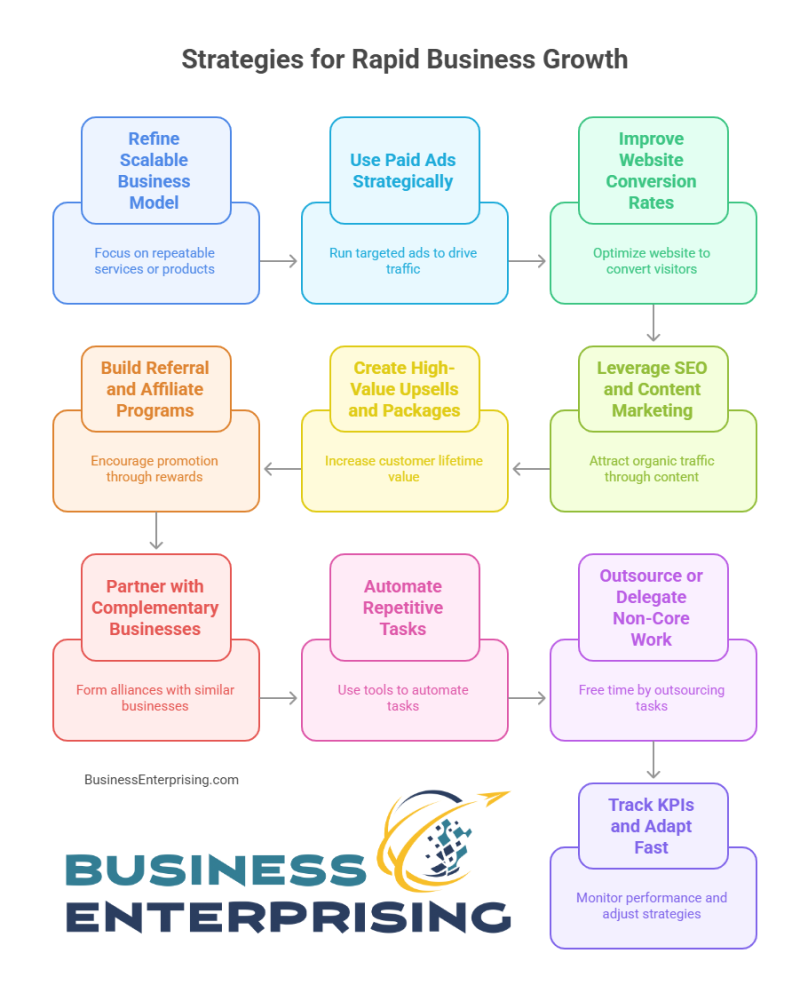 Growing a business quickly takes more than just working harder. You need smart strategies that scale without adding extra stress. Many business owners feel stuck because they try to do everything themselves. However, there are better ways to gain traction and move forward faster.
Growing a business quickly takes more than just working harder. You need smart strategies that scale without adding extra stress. Many business owners feel stuck because they try to do everything themselves. However, there are better ways to gain traction and move forward faster.
Therefore, it helps to focus on systems that do the heavy lifting. These can include automation, smart pricing, or simple upsells. Additionally, strategic partnerships and strong referral systems can bring new leads without high costs. You don’t need to guess what works. Test small changes and track the results carefully.
However, speed doesn’t mean rushing. It means knowing what to fix first. Some tasks waste time without helping revenue grow. That’s why tracking performance is so important. Use real numbers to guide each decision. This keeps your business focused and flexible as it grows.
You don’t need a big budget to build momentum. Instead, work with what you have and keep things simple. Additionally, focus on value over volume. One solid client is often worth more than five small ones. That shift in thinking can free up time and improve cash flow.
If your goal is fast, consistent growth, take a lean and targeted approach. Make changes that save time, increase revenue, or attract better customers. Over time, small adjustments lead to bigger results. You’ll spend less time reacting and more time scaling with purpose.
Clarifying a Scalable Business Model
A scalable business model helps you grow without constantly increasing your workload or overhead. If your revenue depends entirely on your time, growth will stall. You need a structure that lets sales increase without adding equal costs. This type of model creates the space for repeatable success.
Therefore, start by looking at what you can sell repeatedly with minimal extra effort. That might be a digital product, a subscription service, or a clear process others can deliver. Additionally, identify what customers buy most often and build around that. If you rely on one-off transactions, you may have to start from zero each month.
However, a scalable model doesn’t just mean adding more customers. It also means creating a system that works without you. Automating tasks, training others, and using software all support this goal. As you refine these systems, your time frees up. That gives you the ability to focus on strategy and growth instead of daily tasks.
Moreover, it helps to measure what’s working. Use simple metrics to track repeat sales, average revenue, and delivery costs. As patterns emerge, you can test small changes to improve efficiency. Over time, that leads to better margins and less manual effort.
If your goal is growing a business quickly, don’t skip this step. Too many owners rush into expansion without first stabilizing their model. As a result, they burn out or struggle with inconsistency. Instead, build something that grows without always needing more from you.
Optimizing Customer Acquisition Channels
Customer acquisition drives your growth, but not all methods give equal results. If you want more leads, you need to focus. Some channels waste time and money. Others bring consistent results with less effort. You need to know the difference early on.
Paid ads like PPC can bring traffic fast. However, they get expensive if you don’t track performance closely. You should test small budgets first and monitor results daily. If an ad brings in low-quality leads, pause it and rework the offer. Additionally, use landing pages that match the ad message. This helps increase conversions without raising your ad spend.
Organic methods take longer but cost less over time. SEO, for example, works well for attracting steady traffic. Write helpful content using terms your customers search for. Over time, that builds trust and improves your ranking. Additionally, referrals can be powerful. If customers are happy, ask them to spread the word. Offer something in return to make it worth their effort.
However, don’t try every method at once. Start with two or three channels. Track the results and compare the lead quality. Then, shift more time and budget toward what works best. You’ll spend less chasing bad leads and more time closing good ones.
If you’re serious about growing a business quickly, focus on what brings real results. Set clear goals, track performance, and stay consistent. Eventually, your strongest channels will stand out. That’s when you double down and scale what’s already working.
Leveraging Strategic Partnerships
Strategic partnerships can move your business forward faster than working alone. If you find the right collaborators, both sides benefit. You reach new audiences while offering more value. It’s an efficient way to build trust and generate interest without a huge budget.
Therefore, look for partners with customers who need what you offer. These might be service providers, retailers, or content creators. However, they shouldn’t be direct competitors. Instead, choose businesses that complement yours. For example, if you sell skin care, a spa or beauty blogger could be a strong partner.
Additionally, influencers can play a big role. A trusted voice can introduce your brand to thousands of followers. That exposure creates interest and can lead to quick sales. However, work with people who actually believe in your product. Your reputation matters more than short-term gains.
You don’t need complex agreements to get started. Start small and test results. For example, offer a joint promotion or co-host an event. Track how many new leads or customers each effort brings. Then, adjust and improve your next offer.
If your goal is growing a business quickly, partnerships are a smart path. They help you grow faster with less risk. You gain new exposure and build credibility at the same time. When done right, these connections create long-term value for both sides.
Streamlining Operations and Automation
If your business feels stuck, it might be due to manual tasks eating up time. Automating those tasks can free your schedule. You don’t need complex tools to get started. Even small systems can remove daily bottlenecks and help you work smarter.
Additionally, think about what you do each day that someone else could handle. Delegating tasks like customer service, admin work, or scheduling can make a big difference. However, you must be clear with instructions. Simple checklists or screen recordings often help others follow your process with fewer errors.
Therefore, create repeatable systems for everything that happens more than once. That includes onboarding clients, handling orders, or sending emails. When a task follows a standard process, it gets done faster and more consistently. Over time, these systems reduce mistakes and speed up delivery.
Automation tools can also handle simple tasks like email replies, payment follow-ups, or appointment reminders. Additionally, they keep your workflows moving when you’re focused elsewhere. That gives you more time for decisions that actually grow the business.
If you’re focused on growing a business quickly, operations must run without constant input from you. You can’t scale if everything depends on your time. Build a structure that works without daily oversight. Then, you’ll have the bandwidth to grow without burning out.
Focusing on High-Value Offerings and Upsells
Getting more value from each customer helps you grow without chasing constant new traffic. It starts with how you package your offers. When you group products or services into bundles, you make it easier for buyers to spend more. That leads to higher average order values with less selling effort.
Additionally, upsells give your revenue a quick lift. For example, offer a premium version or add-on during checkout. If it fits the customer’s need, they often say yes. Therefore, think about what your buyers usually want next. Offer that upgrade before they have to ask for it.
However, your upsell must make sense. Don’t pitch a service or product that adds no clear benefit. Keep the offer relevant, clear, and easy to accept. This keeps trust high and avoids overwhelming the buyer. Additionally, use email follow-ups to offer upgrades after the sale. Timing matters just as much as the offer.
You can also increase customer lifetime value with subscriptions or recurring services. These options provide steady income without new outreach. When customers pay regularly, your cash flow becomes easier to manage. Over time, even a small monthly fee adds up.
If your goal is growing a business quickly, you need to earn more per customer. That’s how you scale without more traffic or ads. Focus on what keeps buyers coming back and what encourages them to spend a little more each time.
Monitoring KPIs and Pivoting Fast
If you want to stay on track, you need to measure what matters. Guessing leads to waste. Clear data helps you act. Key performance indicators show where your business stands and where it’s heading. Without them, small issues can become expensive problems.
Therefore, track your numbers often. Revenue, conversions, traffic, and costs all paint a picture of what’s working. However, avoid tracking too much. Focus on metrics that tie directly to growth and efficiency. Use simple dashboards that update in real time. That way, you can spot trends before they become trouble.
Additionally, fast action beats slow reflection. If a campaign fails, shift quickly. If a product lags, pause it and test a new one. Many businesses stall because they wait too long to change. You don’t need to be reckless, but you do need to be responsive.
Data gives you the confidence to adjust without second-guessing. However, the numbers don’t speak for themselves. You must check them regularly and ask what they mean. Are leads dropping? Are sales improving? Each answer guides your next step.
If your focus is growing a business quickly, agility matters more than perfection. A slow pivot wastes time and resources. Therefore, watch your KPIs, move fast, and learn from each result. That mindset keeps you in control, even when the market shifts.
Conclusion
Growing a business quickly takes more than just ambition. You need the right systems, strategies, and tools to support your goals. Without a clear plan, it’s easy to waste time on efforts that don’t move the needle. Therefore, focus on what brings the highest return with the least resistance.
Additionally, simplify where you can. If something feels too complicated, it probably is. Streamlined operations and targeted marketing often work better than broad or scattered efforts. However, avoid staying stuck in one approach. Test ideas, review the data, and adapt as needed.
You don’t need to do everything at once. Start with small, meaningful changes that reduce friction. Then, build on what works. As you find repeatable wins, you’ll gain more momentum. Therefore, stay consistent and don’t be afraid to cut what’s not working.
If you want real progress, put energy into actions that scale. That includes partnerships, automation, upsells, and better systems. These tools all reduce the pressure of constant selling. Over time, you’ll notice fewer bottlenecks and more consistent results. Growing a business quickly is possible, but it takes focus and flexibility. Pay attention to what drives results and stay willing to shift. When you treat growth as a process, not a sprint, you build something that lasts.



